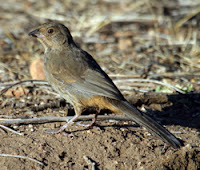
I took this photo with a handheld 640mm stabilized telephoto, shooting right out an open window to the bird about 20' away. Click on the picture for a larger view. About the California Towhee, from the Cornell Laboratory of Ornithology:
California Towhee Pipilo crissalis
Cool fact: The California Towhee was first named as a separate species in 1839. Yet when the first American Ornithologists' Union checklist was published in 1886, it had been lumped with the Canyon Towhee, and the two were known collectively as the Brown Towhee, despite conflicting views held by ornithologists because of the many differences in the two forms' appearances, songs, behaviors, and nests. Relationships between the two forms have recently been clarified through mitochondrial DNA studies, and they are each once again considered full species.
California Towhees are relatively common in brushy habitats from southern Oregon to Baja California and from the Pacific inland to the foothills of the Cascades and the Sierra Nevada. The primary habitat type is chaparral, followed by riparian thickets of alder and willow. Human disturbances have created additional habitat, which is found along roadsides, clearings, and open lawns. California Towhees are permanent residents and, except for the dispersal of juveniles away from nesting areas, are quite sedentary. They are highly territorial birds, aggressively defending their territories year-round. California Towhees often battle their own reflections in windows, hubcaps, and other such reflecting surfaces. Territories range from one to five acres in size.
Nests are sited in dense foliage in shrubs or trees usually within 4 to 12 feet from the ground. Nesting occurs from mid-April through June. The low height and openness of the California Towhee's habitat enables males to detect intruders and rivals visually. Accordingly, song is not as important in territorial defense, and males sing infrequently, most often in the evening. Song is used primarily to attract mates, and birds that sing most are unmated males. The song, delivered from an open perch, consists of the bird's typical chip note repeated three or four times, followed by a descending and decelerating trill. At other times, a faint warbling song can be heard. California Towhees apparently pair for life.
During the breeding season, insects make up most of the towhee's diet; at other times seeds and some fruit are important. Most food is found on the ground, and California Towhees may forage in the manner of Eastern or Spotted Towhees-by scratching the soil using both feet at once. They find water in dry habitats by drinking the dew from grass, and they can be frequent visitors at feeders.
Description: California Towhees are large, unstreaked sparrows (approximately 8.5 to 9.0 inches in length) with long tails. This towhee has a dark brown back, rump, wings, and tail. The crown is warm brown, contrasting slightly with the upperparts. The lores, chin, and throat are cinnamon, and there is a thin necklace of brown spots below the throat. The underparts are slightly paler and more buff-colored than the upperparts; undertail coverts are a distinct cinnamon brown. The bill and legs are brownish, and the eyes are orangish brown. Sexes are indistinguishable. Juveniles are similar to adults but streaked below.
The three brown towhees (California, Canyon, and Abert's) are closely related and similar in appearance. Abert's Towhee (P. aberti) is found in dense streamside thickets in desert areas in southwestern California and southern Arizona. It is distinguished by the dark face that contrasts with its pale bill and by the lack of throat or breast streaking. Canyon Towhees (P. fuscus) tend to inhabit territories at higher altitudes than California Towhees, and the ranges do not overlap. Canyon Towhees are slightly paler and more slender than California Towhees. Canyon Towhees are distinguished by a paler throat with a necklace of dark spots, a contrasting rufous-brown crown (some Mexican races lack this crown), pale buffy (rather than cinnamon) lores, whitish bellies, and a dark spot below the throat necklace.
If Cornell is correct about their territory size, then we have a super-abundance of California Towhees in our yard. We have something like 10 or 12 pairs of them who are either residents of our yard, or who are here so much they might as well be — including one pair who nests in a helmet on our patio!











